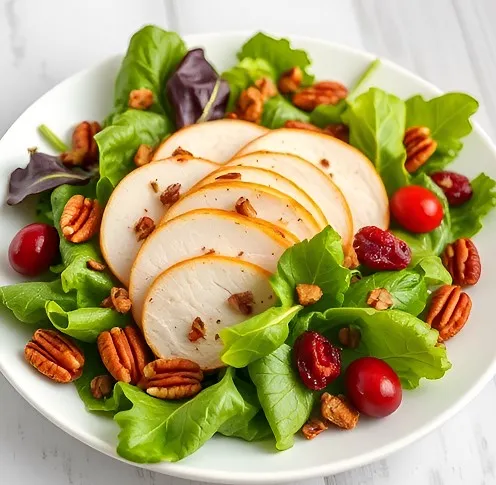When it comes to maintaining a balanced and healthy diet, protein sources play a pivotal role. Among the myriad options available, turkey breast stands out as a nutrient-dense choice that not only satisfies hunger but also contributes significantly to overall well-being. In this article, we delve deep into the nutritional profile of turkey breast, comparing it to other popular proteins, and addressing common questions to help you make informed dietary choices.
Table of Contents
The Nutritional Value
Turkey breast is renowned for its high protein content while being relatively low in fat and calories, making it an excellent choice for those aiming to build muscle or manage weight. A typical 4-ounce serving of cooked turkey breast offers approximately:
- Protein: 35 grams
- Calories: 165
- Fat: 3.6 grams
- Cholesterol: 105 milligrams
- Sodium: 50 milligrams
- Vitamins and Minerals: Rich in B vitamins, particularly niacin (B3) and vitamin B6, which are essential for energy metabolism. It also provides significant amounts of selenium, phosphorus, and magnesium.
This impressive nutritional profile makes it a versatile ingredient in various recipes, from hearty stews to light salads.
Beyond these primary nutrients,contains other essential components that contribute to its health benefits. It is a source of tryptophan, an amino acid that plays a role in serotonin production, potentially aiding in mood regulation and sleep. Additionally, the presence of potassium helps in maintaining proper fluid balance and muscle contractions.
Turkey Breast vs. Chicken: Which is Healthier?
When comparing turkey breast to chicken, both are excellent sources of lean protein. However, there are subtle differences that might sway your preference based on your nutritional goals:
Protein Content: Turkey breast generally contains slightly more protein per ounce than chicken breast, offering about 35 grams compared to chicken’s 31 grams in a 4-ounce serving.
Fat and Calories: Turkey breast tends to be leaner, with fewer calories and less fat than chicken breast. This makes it an ideal choice for those monitoring their caloric intake or aiming to reduce fat consumption.
Vitamins and Minerals: Both meats are rich in B vitamins, but turkey breast offers higher levels of selenium and zinc, which are crucial for immune function and metabolism.
Taste and Texture: While not directly related to nutrition, the taste and texture differences may affect your preference and how you incorporate these proteins into your meals.
In essence, while both turkey and chicken breast are healthy options, turkey breast edges out slightly in terms of protein density and specific nutrient content.
Is Turkey Breast Healthy? Exploring the Benefits
Incorporating turkey breast into your diet can confer numerous health benefits:
Weight Management: Low in fat and high in protein, turkey breast can aid in satiety, helping you feel fuller for longer and reducing overall calorie intake. This can be especially beneficial for those looking to lose weight or maintain a healthy weight.
Muscle Development: The abundant protein supports muscle repair and growth, making it a favorite among athletes and fitness enthusiasts. Regular consumption of high-quality protein sources like turkey breast can enhance muscle synthesis and recovery post-exercise.
Heart Health: Being low in saturated fat and cholesterol, turkey breast supports cardiovascular health by reducing the risk of heart disease. Its nutrient profile, including potassium and magnesium, also contributes to maintaining healthy blood pressure levels.
Bone Strength: Minerals like phosphorus and magnesium present in turkey breast contribute to strong and healthy bones. These minerals work in tandem with calcium to maintain bone density and prevent osteoporosis.
Immune Support: Selenium, found in substantial amounts in turkey breast, plays a role in antioxidant defense and immune system function. Adequate selenium intake is associated with a lower risk of certain cancers and enhanced thyroid function.
Metabolic Health: The B vitamins in turkey breast, particularly B3 (niacin) and B6, are essential for energy metabolism. They help convert food into energy, supporting overall metabolic processes and preventing deficiencies that can lead to fatigue and other health issues.
Digestive Health: While not directly a significant source of fiber, turkey breast can be part of a balanced diet that supports digestive health. Pairing it with fiber-rich vegetables and whole grains can promote healthy digestion and prevent issues like constipation.

Serving Size Matters: Nutritional Insights into 4 Ounces
A 4-ounce serving of turkey breast is a standard portion that fits well within daily dietary recommendations. This serving size provides a substantial protein boost without excessive calories, making it suitable for various meal plans. Beyond protein, it contributes essential nutrients without introducing high levels of sodium or unhealthy fats, aligning with a balanced and health-conscious diet.
Caloric Distribution: In a typical 4-ounce serving, the calorie count of 165 ensures that turkey breast can be included in meals without significantly impacting daily caloric intake. This is particularly useful for those tracking their macronutrients for weight loss or maintenance.
Macronutrient Balance: The balance of protein and low fat content makes turkey breast an ideal component in a macronutrient-balanced diet. It provides the necessary protein for bodily functions while keeping fat intake in check.
Portion Control: Understanding serving sizes helps in managing portion control, which is pivotal for weight management and preventing overeating. A 4-ounce portion is generally recommended to meet daily protein requirements without excess.
Flexibility in Meal Planning: This serving size can be easily incorporated into various meal plans, whether you’re following a high-protein diet, a low-carb regimen, or simply aiming for balanced nutrition.
Incorporating into Your Diet: Recipe Ideas
Given its versatility, turkey breast can be seamlessly integrated into numerous dishes. From classic roasted turkey breast with herbs and spices to innovative turkey breast stir-fries loaded with vegetables, the options are endless. For those seeking lighter fare, turkey breast slices can elevate salads, while hearty soups can benefit from shredded turkey for added protein.
Breakfast Options: can be a fantastic addition to breakfast meals. Consider turkey breast and avocado toast, where lean protein complements healthy fats and fiber-rich whole grains. Another option is incorporating turkey breast into omelets or breakfast burritos for a protein-packed start to your day.
Lunch Ideas: For lunch, is perfect in sandwiches and wraps. Combine it with fresh vegetables, whole-grain bread, and a spread like hummus or mustard for a nutritious meal. Additionally, turkey breast can be diced and added to quinoa or couscous salads, enhancing both flavor and nutritional value.
Dinner Recipes: At dinner, roastedserved with a variety of vegetables and whole grains creates a balanced and satisfying meal. Grilled turkey breast kebabs with vegetables or a turkey breast stir-fry with brown rice and assorted vegetables are both delicious and healthful options.
Snacks and Appetizers: Turkey breast can also be used in snacks and appetizers. Consider turkey breast roll-ups with cheese and vegetables or turkey breast slices paired with whole-grain crackers and dip for a quick, protein-rich snack.
Soups and Stews: Adding to soups and stews not only boosts their protein content but also enhances their flavor and texture. Turkey chili, turkey vegetable soup, or turkey and barley stew are hearty options that provide lasting energy and nutrition.
Salads: breast is an excellent addition to salads, providing a lean protein source that complements fresh greens and vegetables. Try a turkey breast Caesar salad, a turkey and cranberry salad, or a Mediterranean-inspired salad with turkey, olives, and feta cheese.
International Cuisine: Embrace global flavors by incorporating breast into international dishes. Turkey Tikka Masala, turkey fajitas, or turkey schnitzel are all creative ways to enjoy turkey breast with diverse culinary influences.
The Role of Breast in a Balanced Diet
Including breast in your diet contributes to a balanced intake of essential nutrients. It complements other food groups, ensuring you receive a wide range of vitamins and minerals necessary for optimal health. Pairing it with vegetables, whole grains, and healthy fats creates meals that are not only nutritious but also satisfying and flavorful.
Protein Synergy: Combining turkey breast with other protein sources, such as legumes or dairy, can enhance the overall protein content of your meals. This is particularly beneficial for individuals with higher protein requirements, such as athletes or those recovering from illness.
Nutrient Diversity: Diversifying your protein sources with turkey breast ensures a broader spectrum of nutrients. While turkey breast is rich in certain vitamins and minerals, other proteins like fish or tofu can provide different nutrients, contributing to overall dietary balance.
Caloric Distribution: Including turkey breast in your meals helps distribute caloric intake evenly throughout the day. This prevents excessive calorie consumption in a single meal and supports sustained energy levels.
Dietary Variety: Incorporating a variety of foods, including turkey breast, prevents diet monotony and promotes adherence to healthy eating patterns. Variety also ensures that you receive a wide array of nutrients necessary for different bodily functions.
Sustainable and Ethical Considerations
In today’s health-conscious and environmentally aware society, sustainable and ethical considerations play a significant role in dietary choices. , when sourced responsibly, can be a sustainable protein option.
Sustainable Farming Practices: Choosing it from producers that adhere to sustainable farming practices ensures that the environmental impact is minimized. Practices such as responsible land use, water conservation, and humane animal treatment contribute to the overall sustainability of turkey production.
Environmental Impact: Compared to red meats like beef, the recipe generally has a lower environmental footprint. It requires fewer resources to produce and results in lower greenhouse gas emissions, making it a more eco-friendly protein choice.
Ethical Sourcing: Opting for turkey breast from sources that prioritize animal welfare ensures that the animals are raised in humane conditions. Certifications such as organic, free-range, or pasture-raised can guide ethical purchasing decisions.
Healthier Alternatives to Processed Meats: Choosing fresh dish over processed turkey products reduces exposure to additives, preservatives, and excessive sodium commonly found in processed meats. This not only benefits personal health but also promotes more sustainable food consumption patterns.
Maximizing Nutrient Absorption and Health Benefits
To fully harness the nutritional benefits of recipe, it’s essential to consider factors that maximize nutrient absorption and overall health.
Cooking Methods: The way you prepare breast can impact its nutritional value. Opting for cooking methods like grilling, baking, or steaming preserves its protein content and minimizes added fats. Avoiding frying or excessive use of oils helps maintain its lean profile.
Pairing with Complementary Foods: Combining breast with foods rich in vitamin C, such as bell peppers or citrus fruits, can enhance iron absorption from the meat. Including healthy fats from sources like olive oil or avocados aids in the absorption of fat-soluble vitamins.
Avoiding Overcooking: Overcooking breast can lead to the loss of essential nutrients and result in a drier texture. Using methods that retain moisture, such as sous-vide or brining before roasting, ensures that the meat remains tender and nutrient-rich.
Balanced Portions: Ensuring that turkey breast is part of a balanced meal that includes carbohydrates, fats, and fiber promotes overall nutrient balance and supports sustained energy levels throughout the day.
Mindful Eating Practices: Practicing mindful eating by savoring each bite and paying attention to hunger and fullness cues can enhance digestion and nutrient absorption. It also fosters a healthier relationship with food, promoting long-term dietary adherence.
Addressing Common Questions
What is the nutritional value of a turkey breast?
A turkey breast offers high-quality protein, low fat, and essential vitamins and minerals, including B vitamins, selenium, phosphorus, and magnesium, making it a nutritious addition to a balanced diet.
Is turkey breast better for you than chicken?
Both are excellent lean protein sources, but turkey breast generally contains slightly more protein and fewer calories and fat per serving compared to chicken breast. Additionally, turkey breast provides higher levels of certain nutrients like selenium and zinc.
What is the nutritional value of 4 oz of turkey breast?
A 4-ounce serving of cooked turkey breast contains approximately 35 grams of protein, 165 calories, 3.6 grams of fat, 105 milligrams of cholesterol, and 50 milligrams of sodium, along with essential vitamins and minerals.
Is turkey breast healthy?
Yes, turkey breast is a healthy protein choice. It supports weight management, muscle development, heart health, bone strength, and immune function due to its rich nutritional profile.
Can turkey breast help with weight loss?
Absolutely. Its high protein and low-fat content make it an ideal food for weight loss. Protein promotes satiety, reducing overall calorie intake by keeping you feeling full longer.
Are there any risks associated with consuming turkey breast?
When consumed in moderation and prepared healthily, turkey breast is safe for most individuals. However, excessive consumption may contribute to high cholesterol levels due to its cholesterol content. It’s also important to choose unprocessed turkey to avoid high sodium levels found in some processed products.
How does the nutrient profile of turkey breast support athletic performance?
The high protein content aids in muscle repair and growth, while the B vitamins support energy metabolism. Selenium and iron contribute to reduced fatigue and enhanced immune function, crucial for maintaining peak athletic performance.
Can turkey breast be included in a vegetarian or vegan diet?
While turkey breast itself is not suitable for vegetarians or vegans, it can be incorporated into flexitarian diets where occasional meat consumption is accepted. For strict vegetarians or vegans, plant-based protein sources should be prioritized.
How should turkey breast be stored to maintain its nutritional quality?
Fresh turkey breast should be stored in the refrigerator and consumed within a few days of purchase. For longer storage, freezing is recommended. Proper storage prevents nutrient degradation and ensures food safety.
What are some signs of high-quality turkey breast?
High-quality turkey breast should have a firm texture, a light pink color, and a fresh, mild aroma. Avoid products that appear slimy, have an off smell, or exhibit discoloration, as these may indicate spoilage.
Enhancing Your Meals with Breast: Advanced Recipe Ideas
To truly appreciate the versatility and nutritional benefits of turkey breast, consider exploring a variety of advanced recipes that highlight its adaptability in different cuisines and cooking techniques.
Herb-Crusted Roasted Breast:
Marinate the turkey with a blend of fresh herbs like rosemary, thyme, and sage, along with garlic and lemon juice. Roast it to perfection, ensuring a flavorful and succulent main dish that pairs well with roasted vegetables and quinoa.
the Breast and Sweet Potato Shepherd’s Pie:
Replace traditional ground meat with shredded turkey in a hearty shepherd’s pie. Layer it with mashed sweet potatoes and an array of vegetables for a comforting and nutritious meal.
Spicy Turkey Breast Tacos:
Season the meat with a mix of spices such as cumin, paprika, and chili powder. Serve in whole-grain tortillas with fresh salsa, avocado, and a squeeze of lime for a spicy and satisfying taco night.
Turkey Breast Bolognese Pasta:
Utilize ground turkey in a rich Bolognese sauce, simmered with tomatoes, onions, garlic, and Italian herbs. Serve over whole-wheat pasta or zucchini noodles for a protein-packed Italian favorite.
Turkey Breast Sushi Rolls:
Incorporate cooked turkey into sushi rolls along with vegetables like cucumber, avocado, and carrot. Serve with soy sauce and wasabi for a unique twist on traditional sushi.
Turkey Breast Lettuce Wraps:
Sauté the meat with Asian-inspired flavors such as ginger, garlic, and soy sauce. Serve in crisp lettuce leaves with shredded carrots and water chestnuts for a low-carb, high-protein meal option.
Mediterranean Breast Stuffed Peppers:
Fill bell peppers with a mixture of diced turkey, quinoa, olives, feta cheese, and herbs. Bake until the peppers are tender for a flavorful and nutrient-dense dish.
Breast and Vegetable Stir-Fry:
Combine turkey strips with a colorful assortment of vegetables like bell peppers, broccoli, and snap peas. Stir-fry with a sauce made from soy sauce, ginger, and garlic for a quick and healthy meal.
Breast Enchiladas:
Wrap turkey pieces in whole-grain tortillas, cover with enchilada sauce and a sprinkle of cheese, then bake until bubbly. Serve with a side of black beans and a fresh salad.
Smoked Breast Salad with Cranberries and Pecans:
Create a sophisticated salad by layering smoked turkey with mixed greens, dried cranberries, toasted pecans, and a balsamic vinaigrette. This combination offers a balance of sweet, crunchy, and savory flavors.

Maximizing the Health Benefits
To fully leverage the health benefits of turkey breast, consider these strategies:
Balanced Plate Approach: Ensure that your meals featuring turkey also include a variety of vegetables, whole grains, and healthy fats to create a well-rounded and nutritionally complete meal.
Meal Prepping: Preparing turkey in advance can help maintain a healthy diet throughout the week. Grilling or baking multiple portions at once allows for easy incorporation into various meals, reducing the temptation to opt for less nutritious options.
Mindful Cooking: Use herbs, spices, and natural flavorings to enhance the taste of turkey without adding unhealthy fats or excessive sodium. This approach maintains the health benefits while keeping meals delicious.
Variety in Preparation: Rotate different cooking methods and recipes to prevent dietary monotony and ensure a diverse intake of nutrients. This variety also keeps meals interesting and enjoyable.
Incorporating Superfoods: Pair turkey with superfoods like leafy greens, berries, nuts, and seeds to boost the overall nutrient density of your meals. These combinations can enhance the antioxidant and anti-inflammatory properties of your diet.
Conclusion: Embracing recipe a Healthier You
Turkey breast stands as a testament to how delicious food can also be nutritionally beneficial. Its high protein content, coupled with low fat and calorie counts, makes it an excellent choice for those striving for a healthy lifestyle. Whether you’re an athlete looking to build muscle, someone aiming to lose weight, or simply seeking to diversify your protein sources, turkey offers both flexibility and sustenance. By understanding its nutritional value and integrating it thoughtfully into your meals, you can harness the benefits of turkey breast for a healthier, more balanced diet.

